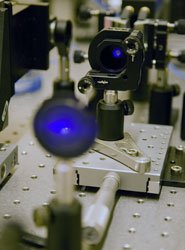Sep 3 2009
A primitive quantum computer that uses single particles of light (photons) whizzing through a silicon chip has performed its first mathematical calculation. This is the first time a calculation has been performed on a photonic chip and it is major step forward in the quest to realise a super-powerful quantum computer.
 A quantum photonic experiment. Photo by Jonathan Matthews
A quantum photonic experiment. Photo by Jonathan Matthews
The chip takes four photons that carry the input for the calculation, it then implements a quantum programme (Shor's algorithm) to find the prime factors of 15, and outputs the answer – 3 and 5. The results are reported by a team of physicists and engineers from the University of Bristol in today's issue of Science.
“This task could be done much faster by any school kid,” said PhD student, Alberto Politi, who, together with fellow PhD student Jonathan Matthews performed the experiment, “but this is a really important proof-of-principle demonstration.”
Finding prime factors may seem like a mathematical abstraction, but it lies at the heart of modern encryption schemes, including those used for secure internet communication. The ability of quantum computers to simulate quantum systems may also prove to be a powerful tool in the development of new materials or pharmaceuticals.
The team from the University of Bristol's newly established Centre for Nanoscience and Quantum Information have spent several years developing devices where photons propagate in silica waveguides — much like in optical fibres — micro-fabricated on a silicon chip.
“This approach results in miniature, high-performance and scalable devices,” said Professor Jeremy O'Brien, Director of the Centre for Quantum Photonics, who led the research. “The realisation of a quantum algorithm on a chip is an extremely important step towards an all-optical quantum computer”
“Despite recent advances, the ability to perform even small-scale quantum algorithms has largely been missing,” said Matthews. “For the last few years, researchers at the Centre for Quantum Photonics have been working towards building fully functional quantum circuits on a chip to solve this issue,” added O'Brien.
The team coupled four photons into and out of the chip using optical fibres. On the chip the photons traveled through silica waveguides that were brought together to form a sequence of quantum logic gates. The output was determined by which waveguides the photons exited the chip in. By detecting the photons at the output of the device they confirmed high-performance operation of the quantum algorithm.
“As well as quantum computing and quantum metrology, ‘on-chip' photonic quantum circuits could have important applications in quantum communication, since they can be easily integrated with optical fibres to send photons between remote locations,” said Politi.
O'Brien concurred and added: “The really exciting thing about this result is that it will enable the development of large scale quantum circuits for photons. This opens up all kinds of possibilities”.